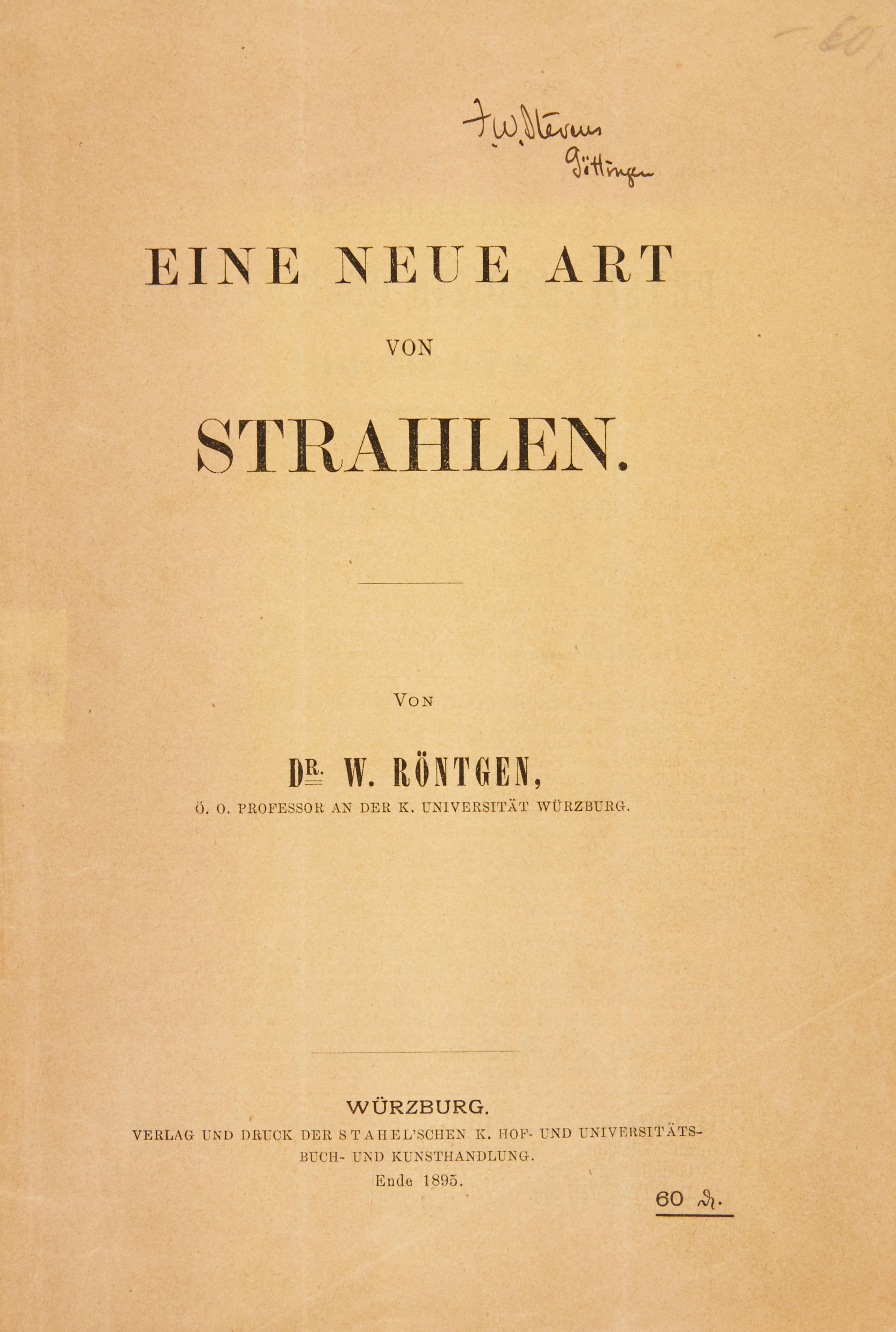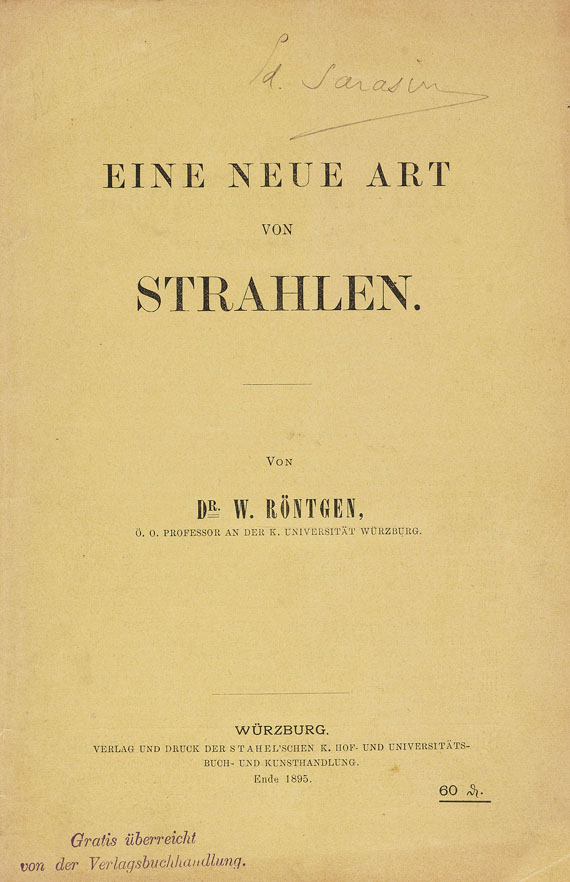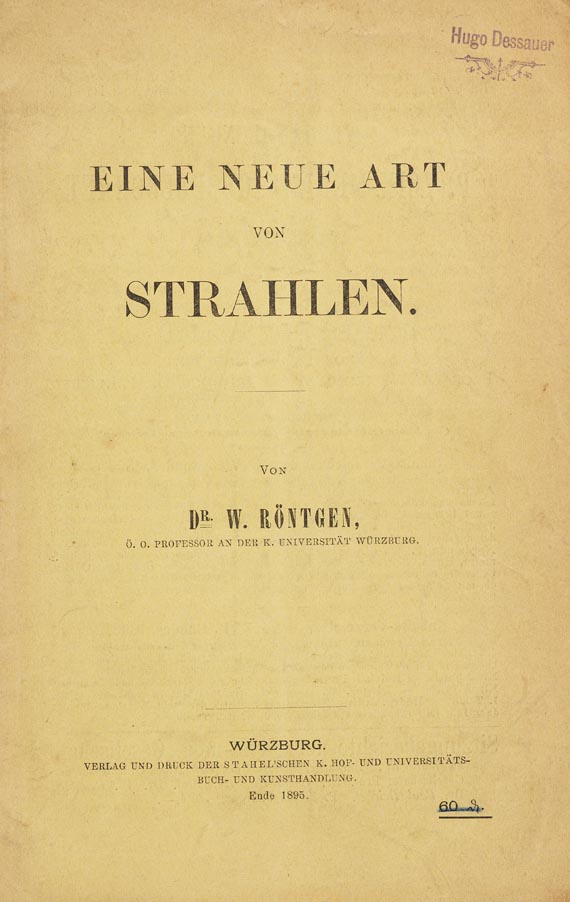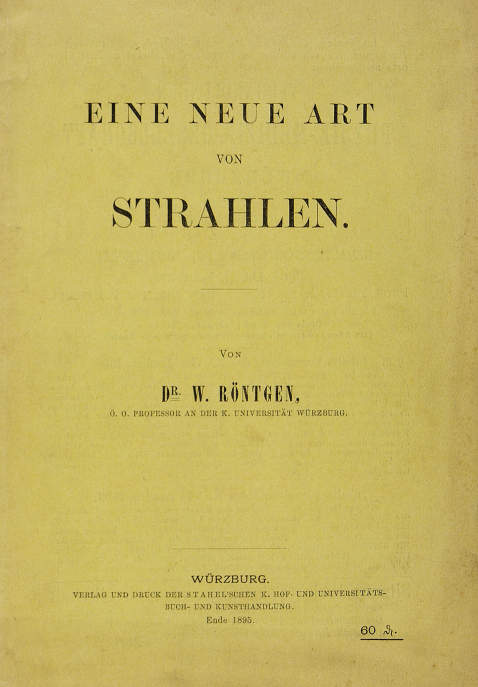RÖNTGEN, Wilhelm Conrad (1845-1923). Ueber eine neue Art von Strahlen (Vorläufige Mittheilung). -- Eine neue Art von Strahlen. II. Mittheilung. Offprints from: Sitzungsberichte der Würzburger Physik.-medic. Gesellschaft, 1895 [no. 9], and 1896, [nos. 1-2]. Würzburg: Verlag und Druck der Stahel'schen k. Hof.-und Universitäts- Buch- und Kunsthandlung, 1895-1896.
RÖNTGEN, Wilhelm Conrad (1845-1923). Ueber eine neue Art von Strahlen (Vorläufige Mittheilung). -- Eine neue Art von Strahlen. II. Mittheilung. Offprints from: Sitzungsberichte der Würzburger Physik.-medic. Gesellschaft, 1895 [no. 9], and 1896, [nos. 1-2]. Würzburg: Verlag und Druck der Stahel'schen k. Hof.-und Universitäts- Buch- und Kunsthandlung, 1895-1896. 2 volumes, 8 o . Original yellow (part I) and orange (part II) printed wrappers (small chip to edge of front wrapper of part I, some light darkening); cloth chemise and brown quarter morocco slipcase. [ With :] "Hand des Anatomen Geheimrath von Kölliker in Würzburg. Im Physikalischen Institut der Universität Würzburg am 23. Januar 1896 mit X-Strahlen aufgenommen. Würzburg: Verlag und Druck der Stahel'schen k. Hof.-und Universitäts- Buch- und Kunsthandlung, 1896. Photographic illustration mounted on card. Cloth chemise, and green quarter morocco slipcase. THE ANNOUNCEMENT OF THE DISCOVERY OF THE X-RAY FIRST EDITION, offprint issue. Although it had certainly manifested itself to earlier experimentors, the portion of the electromagnetic spectrum known in Germany as Röntgenstrahlen was not taken note of, i.e., "discovered", until 1895. In the autumn of that year Röntgen, an unassuming physics professor at Würzburg, undertook a series of experiments with William Crookes' version of the "Geisslertube," a form of vacuum tube sealed at the ends with platinum terminals to permit the passage of an electric current through the tube. "Hertz and Lenard had published on the penetrating powers of cathode rays (electrons) and Röntgen thought that there were unsolved problems worth investigation... As a preliminary to viewing the cathode rays on a fluorescent screen, Röntgen completely covered his discharge tube with a black card, and then chanced to notice that such a screen lying on a bench some distance away was glowing brightly. Although others had operated Crookes tubes in laboratories for over thirty years, it was Röntgen who found that X rays are emitted by the part of the glass wall of the tube that is opposite the cathode and that receives the beam of cathode rays. He spent six weeks in absolute concentration, repeating and extending his observations on the properties of the new rays. He found that they travel in straight lines, cannot be refracted or reflected, are not deviated by a magnet, and can travel about two meters in air. He soon discovered the penetrating properties of the rays... The apparent magical nature of the new rays was something of a shock even to Röntgen... On 22 December he brought his wife into the laboratory and made an X-ray photograph of her hand. It was no doubt the possibility of seeing living skeletons, thus pandering to man's morbid curiosity, that contributed to the peculiarly rapid worldwide dissemination of the discovery" ( DSB ). This quick dissemination of a scientific discovery was in fact made possible by the custom of sending offprints of articles published in obscure scholarly journals to distant colleagues. To ensure priority for his discovery, Röntgen immediately submitted a "preliminary" paper on the "new kind of rays," which he had dubbed "X rays" because of his uncertainty as to their origin, to the editors of the Physical and Medical Society of Würzburg in the last week of December, 1895. The present offprint was printed at the same time as the journal number, which "probably was not actually published until January 1896" (Grolier Medicine ): "By 1 January 1896 Röntgen was able to send reprints [i.e., offprints] and, in some cases, photographs to his friends and colleagues... The Wiener Press carried the story of the discovery on 5 January, and on the following day the news broke around the world. The world's response was remarkably swift, both the general public and the scientific community reacting in their characteristic ways. For the former, the apparent magic caught the imagination, and for the latter, Crookes tubes and gener
RÖNTGEN, Wilhelm Conrad (1845-1923). Ueber eine neue Art von Strahlen (Vorläufige Mittheilung). -- Eine neue Art von Strahlen. II. Mittheilung. Offprints from: Sitzungsberichte der Würzburger Physik.-medic. Gesellschaft, 1895 [no. 9], and 1896, [nos. 1-2]. Würzburg: Verlag und Druck der Stahel'schen k. Hof.-und Universitäts- Buch- und Kunsthandlung, 1895-1896.
RÖNTGEN, Wilhelm Conrad (1845-1923). Ueber eine neue Art von Strahlen (Vorläufige Mittheilung). -- Eine neue Art von Strahlen. II. Mittheilung. Offprints from: Sitzungsberichte der Würzburger Physik.-medic. Gesellschaft, 1895 [no. 9], and 1896, [nos. 1-2]. Würzburg: Verlag und Druck der Stahel'schen k. Hof.-und Universitäts- Buch- und Kunsthandlung, 1895-1896. 2 volumes, 8 o . Original yellow (part I) and orange (part II) printed wrappers (small chip to edge of front wrapper of part I, some light darkening); cloth chemise and brown quarter morocco slipcase. [ With :] "Hand des Anatomen Geheimrath von Kölliker in Würzburg. Im Physikalischen Institut der Universität Würzburg am 23. Januar 1896 mit X-Strahlen aufgenommen. Würzburg: Verlag und Druck der Stahel'schen k. Hof.-und Universitäts- Buch- und Kunsthandlung, 1896. Photographic illustration mounted on card. Cloth chemise, and green quarter morocco slipcase. THE ANNOUNCEMENT OF THE DISCOVERY OF THE X-RAY FIRST EDITION, offprint issue. Although it had certainly manifested itself to earlier experimentors, the portion of the electromagnetic spectrum known in Germany as Röntgenstrahlen was not taken note of, i.e., "discovered", until 1895. In the autumn of that year Röntgen, an unassuming physics professor at Würzburg, undertook a series of experiments with William Crookes' version of the "Geisslertube," a form of vacuum tube sealed at the ends with platinum terminals to permit the passage of an electric current through the tube. "Hertz and Lenard had published on the penetrating powers of cathode rays (electrons) and Röntgen thought that there were unsolved problems worth investigation... As a preliminary to viewing the cathode rays on a fluorescent screen, Röntgen completely covered his discharge tube with a black card, and then chanced to notice that such a screen lying on a bench some distance away was glowing brightly. Although others had operated Crookes tubes in laboratories for over thirty years, it was Röntgen who found that X rays are emitted by the part of the glass wall of the tube that is opposite the cathode and that receives the beam of cathode rays. He spent six weeks in absolute concentration, repeating and extending his observations on the properties of the new rays. He found that they travel in straight lines, cannot be refracted or reflected, are not deviated by a magnet, and can travel about two meters in air. He soon discovered the penetrating properties of the rays... The apparent magical nature of the new rays was something of a shock even to Röntgen... On 22 December he brought his wife into the laboratory and made an X-ray photograph of her hand. It was no doubt the possibility of seeing living skeletons, thus pandering to man's morbid curiosity, that contributed to the peculiarly rapid worldwide dissemination of the discovery" ( DSB ). This quick dissemination of a scientific discovery was in fact made possible by the custom of sending offprints of articles published in obscure scholarly journals to distant colleagues. To ensure priority for his discovery, Röntgen immediately submitted a "preliminary" paper on the "new kind of rays," which he had dubbed "X rays" because of his uncertainty as to their origin, to the editors of the Physical and Medical Society of Würzburg in the last week of December, 1895. The present offprint was printed at the same time as the journal number, which "probably was not actually published until January 1896" (Grolier Medicine ): "By 1 January 1896 Röntgen was able to send reprints [i.e., offprints] and, in some cases, photographs to his friends and colleagues... The Wiener Press carried the story of the discovery on 5 January, and on the following day the news broke around the world. The world's response was remarkably swift, both the general public and the scientific community reacting in their characteristic ways. For the former, the apparent magic caught the imagination, and for the latter, Crookes tubes and gener















Testen Sie LotSearch und seine Premium-Features 7 Tage - ohne Kosten!
Lassen Sie sich automatisch über neue Objekte in kommenden Auktionen benachrichtigen.
Suchauftrag anlegen